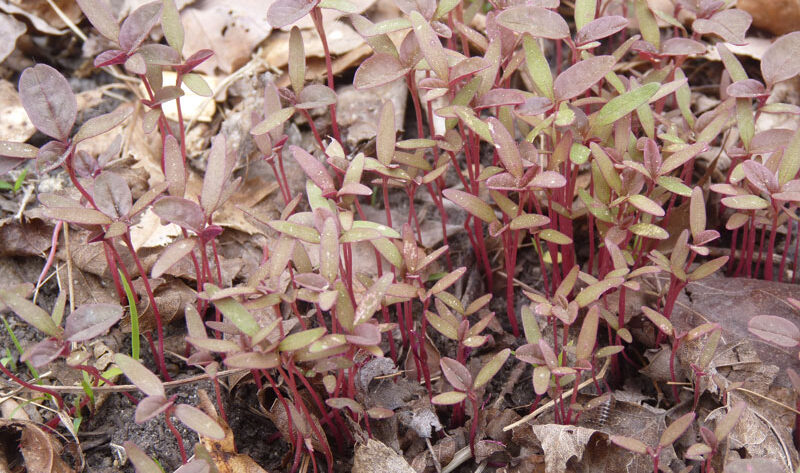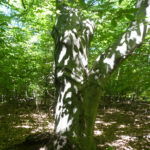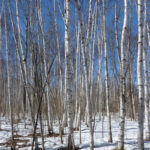This month, I’ll have been walking a forest/druidic path for seven years. This experience includes founding a druid grove, being active in two druid orders, attending multiple druid and larger neo-pagan gatherings, mentoring others, and so forth. And based on those experiences, I’ve come to see the importance of weaving in magical traditions with more practical action, of embracing sustainability and more earth-centered living as a fundamental part of my druid path. If sustainability is a goal of modern druidry, and if druidry seeks to embrace the idea of earth centeredness, then investigating the idea of being “deeply rooted in the living earth” and “embracing sustainability” is worthy of consideration. In this post, I’ll talk about some of my own philosophy and experiences in making the shift towards sustainability with the hopes that this information can help others who want to make similar sustainable shifts also do so.

For druids, nature is the canvas on which we paint our spirituality. We layer mythology, experiences in the natural world, observations, and engage in esoteric practices that allow us to interact with the land. We revere nature, her spirits, her deities, and we enjoy nothing better than being out in wild spaces communing with nature. As part of this work, of course, druids think about these natural spaces–if the world is a sacred place, how do we conserve it? How do we preserve it? The task seems so enormous, it can be overwhelming. Can we, as druids, become leaders of sustainability in our communities? I would say, yes, we can, and we are already starting to do so. We just need to keep pushing in this direction–and understand what resources we have and what areas we might draw upon to give us a better idea of how “embracing sustainability” can be done.
The druidic principles and philosophies, combined with more modern writings on the druid tradition published in the last 60 or so years, provide us an excellent grounding, especially from a spiritual side, to address sustainability. Yet, we are still left wondering how to operate in the 21st century where we are facing a period unlike any other in human history: where environmental destruction is rampant, industrialization is declining, and humanity is largely turning a blind eye to the effects of our own greed. Where the power to make change, at least on a large-scale level, continues to be concentrated into the hands of those for whom change is not in their best economic interests. So how do we respond as druids? Where might we go for more information?
Tracing the roots of today’s Druidry reveals some powerful practices that can help us embrace a sustainability mindset, but also areas where we might need to go beyond our own history for additional guidance. Druidry, at least the Revival Druidry that I practice, draws its inspiration primarily from two sources: ancient Celtic traditions, mythology and teachings and the Druid Revival period in the 18th and 19th centuries. The Ancient Celts never faced the kinds of ecological challenges that we faced today, but they did live rooted in the land in ways that we can embrace. The Druid Revival, the second source of much druidic philosophy today, developed around the same time that industrialization did. The impact of the industrial revolution at the time had yet to be realized–and, I suspect, some of the reason that the druidic tradition grew in the first place was to build community and restore a connection to the land while in such an industrialized and challenging time. Even so, when reading these early revival works (and the Druid Revival Reader is a great place to understand this history further) the Revival Druids’ primary emphasis was on the esoteric side, specifically in building and creating lodge practices. These practices are powerful, they give us much in terms of working principles, philosophies, and ethics, but they don’t necessarily tell us directly how to live sustainable lives. So we have roots of sustainability within these traditions, but not necessarily overt principles–this is where other movements can help guide our path.
Since druidry itself does not have an explicit tradition emphasizing sustainability, one way of embracing sustainability is to connect to other nature-based movements that clearly align with our principles and that can teach us the skills to become more sustainable. And druids do this kind of work often–we draw upon many traditions to create our individual spiritual paths.
Some of these other sources of inspiration and tradition can be found in the permaculture and deep ecology movements. I’ve spent a lot of time on this blog talking about permaculture; when I read Gaia’s Garden: A Home-Scale Guide to Permaculture, I felt it was one of the most druidic books I had ever read. And it didn’t use the word “druid” once; it had no meditation, ritualistic, or other esoteric practices. But what it did resonated with me deeply. It asked me to observe, to use patterns in nature, and to completely re-see my interaction with the world and to question every interaction with nature that I had (and these were things I was already doing in AODA druidry, just in a slightly different way). This book, which I read about three years ago, radically shifted my worldview. Other principles, like Deep Ecology, can provide us an ethical framework for understanding the world paired with specific actions and techniques for making real change. Deep ecology includes principles like “re-earthing”, which asks us to expand our connection to nature and expand our own idea of identity to closely align with other life. Philosophical principles, like those espoused by Blackstone’s Philosophy and the Environmental Crisis and other environmental philosophers, can also give us some insight. The nice thing is that most of these principles completely align with druidry, but in this case, they are more closely linked to ecological action and present us new resources and ways of deepening our understanding of sustainability. I have found in my own practice that by aligning with these movements, I was able to bring the physical and the spiritual in harmony; I was able to develop a more complete philosophy of living, growing, interacting, and respecting our living world. I’ll be looking at some of these principles in more detail upcoming blog posts this year and continue to further articulate the embracing sustainability druidic philosophy that I am describing here.

Embracing sustainability as part of druidic practice is obviously compatible with the broader movement of druidry. When we think about common definitions of magic, and ways of working magic, one of the basic principles is that magical practices should also have a physical component. In my own emphasis on sustainable living, I’ve found that the real magic happens when we combine physical action with spiritual approaches. If I’m doing some spiritual healing of the land, which I find myself often called to do, physical healing of the land in any capacity enriches that magical practice (and this might be something as simple as picking up garbage or throwing a few native seed balls into an abandoned lot).
To show how the shift to embracing sustainability can happen, I’ll use myself as a case study, to demonstrate my own evolution in thinking on these issues. I became a druid about seven years ago. I had lost my close friend, my Anam Cara, and I had a spiritual awakening and found druidry as part of my grieving process. I joined the Ancient Order of Druids in America and began working through the 1st degree curriculum. As part of that curriculum, I was asked to make three lifestyle changes to minimize my impact on the living earth, to spend time each week in direct observation and meditation in nature, to celebrate the wheel of the year and the turning seasons, and so forth. I appreciated these connections, and I did these things joyfully. But my emphasis was on more esoteric and spiritual matters–divination, spiritual crafting, embracing the bardic arts, ritual work, etc. Looking back, I feel like I gave sustainability lip service, I did my part to recycle, visit the farmer’s market, read about ecology, use public transportation and limit my trips, and yet I didn’t really embrace it as a life philosophy. I was still firmly rooted within consumer culture, critical but not yet very active. The AODA 1st degree Curriculum began that awakening process, it planted the seeds, but it was up to me to continue to push forward.
As time passed, my spiritual senses awakened, and I started realizing that I could sense the dissonance between my lifestyle and my spiritual practices. I could sense, physically and spiritually, the destruction of the land and the lack of respect. It was like I needed several years of incubation before really coming to an understanding about what my druidry really meant, what my druidry really needed to be. Druidry became not a religion or spiritual practice that I did only once in a while but as something I lived EVERY minute of every day. And when I made that shift, I had to change my interaction with the world. At that point, I worked slowly but determinedly (as permaculture emphasizes small, slow, sustainable solutions) to more fully integrate sustainability as a spiritual practice. This has lead me to radically shift my eating, my daily living, my hobbies, and in co-founding a local permaculture group to build community and bring others together to share and grow. So for me, druidry, ultimately, is a “this is what I do” religion/spiritual path. When people ask me about who I am as a druid, I talk about my actions and how they are in harmony with my beliefs. I try to treat the earth as sacred through every one of my daily actions. I also believe that part of this path leads to reskilling, spending time with others who are enacting sustainable practices, learning all that I can, and teaching anytime I am able.
How can we approach this seemingly enormous task of preserving the sacredness of all life and enacting druidry? I would argue we can do so by embracing sustainability as both a philosophical orientation and a practice of direct action.So if embracing sustainability is something that you are building (or want to build into your own druidic or earth-centered spiritual path), there are a lot of resources out there to get you started. I’ve blogged extensively about sustainability on this blog, for example: ten tips to get started reducing your impact on the planet, books to read, ways of seeing/thinking, going localvore, six principles for local eating, and much more! Meadows, Randers, and Meadows discuss in their closing of The Limits to Growth (30 year update), when they say that they are continually demoralized by trying to enact sustainable change at the national and international levels, but always energized by what was occurring a the local level in smaller communities. (For readers interested in this phenomenon, John Michael Greer had a great explanation of the governance issues with the disconnect between national decision-makers and local community empowerment last month in his Archdruid Report Blog). In fact, I would recommend any of John Michael Greer’s books on peak oil (such as the Long Descent) to educate yourself further on these issues.
I’d like to conclude with some questions that might aid us in considering the role of sustainability more fully in druidry. Can we, as druids, put the preservation of wild spaces at the forefront of our efforts? Can we, as druids, engage in more substantial discussions about to minimize our impact on the planet? Is sustainability one of our core values of druidry? Should it be? I think for many it is, but I also wonder if we can do more–if we can embed sustainability more fully into our training program/druid order curricula, if we can more fully discuss it at our gatherings, if we make it a strong presence in our groves, and if we can have more discussions of sustainability in our blogs and online interactions.
Sustainability and change isn’t just about the big events, the government structures, the online petitions. Sustainability is about each and every action we take, each decision we make, and how we integrate sustainable practices into our daily lives in ways that are meaningful, powerful, and spiritually significant.




Loved, loved, LOVED this piece. One of the reasons we moved to a co-housing community was because we wanted to share resources and lessen our impact. There is still a ton of work to be done, but we’re all moving in that direction.
Greer’s last post was a real eye-opener as to how funding and government have been become less and less localized. I feel fortunate to live in New England where the town meeting is still alive and well, but increased centralization should be worrisome to anyone paying attention.
Cat, I’d love to hear more about your co-housing community. I’d love to live in something like that here!
And yes, the increased centralization and control is very worrisome, especially for sustainability and community-based practices. Joel Slatin’s Everything I want to do is Illegal book comes to mind (although some of his resistance was at the local level, but the amounts of rules and regulations at any level are intimidating these days).
Very well said. Too many people talk the talk but don’t walk the walk.
Great post. I feel the push to walk-the-talk in druidry, paganism, and esoteric groups in regards to how we treat the earth is going to grow as our resource base lessens. This doesn’t mean we should wait to get started, because as you said, those of us who are transitioning will need to be available to teach others.
One of the books I’m reading now that is currently re-writing my brain is Permaculture Principles and and Pathways Beyond Sustainability by David Holmgren. This is a philosophical book that gets to the core of the permaculture principles. I highly recommend it. As the AODA teaches discursive meditation, its one of my own projects to meditate on each permaculture principle several times to really internalize the teachings.
Scarlet Imprint, an occult publisher, is one of the publishers who are really moving forward with work from many traditions that is critical of industrial culture -and calls not just for thought about it, but action!
Again, resources like your blog here will help pave the way. I hope you write a book someday about your sustainable magical practices and craft.
Hi Justin, thanks for the comment! I really like Homgren’s work–I have his Permaculture Principles book too :). Using the principles and ethics for themes for discursive meditation is a great idea–I need to blog about that :).
Another good book, if you can get your hands on one (it’s regrettably out-of-print) is The Green Reader, ed. by Andrew Dobson. I used it for teaching research writing to college students for many
years, and I think it is what grounded my own spiritual path. Another example of living the Druid path every minute of every day was being able to share resources like that one (I always teach around the theme of The Sustainable Society).
Thanks for posting and for the reference, Caleenrua! 🙂
“Walk Your Talk!” It is a simple philosophy in those three words that can mean a world of change over time.
I really enjoyed reading this blog, and agree with you about needing to focus on the doing part. This is one of the things I love about the AODA. It encourages small changes, which are in themselves sustainable, and that, in turn can lead to more changes that are also sustainable.
Another three word philosophy: “Lead By Example!” If we all walk our talk and lead by example, things will change for the better! 🙂
Hugs, Lex xxx
Lexie: wonderful three-word philosophies! And yes, I think these principles are both embraced by the AODA! 🙂
Though no druid I am aware from my study of Celtic philosophy that there is considerable material available to support an argument of sustainability from stewardship to relationships with the land. I am glad you are advocating sustainability to druids. I know the oak is important to the druid, a tree that reaches out to the heavens but also has the roots firmly anchored into the land.
I’m an old country boy from Canada who has slowly been working towards self-sufficency/sustainability for years. My parents an grand-parents were raised that way in the years before the world wars an I was taught a lot of that knowledge growing up. They didn’t use the words organic or sustainability they just lived it because that’s the way it was. Big government an big business have radically changed things since the end of the last world war. I commented before that people have to stop with the butisms an just start doing what they dream of. Grass roots an local community responses to global problems is the only way. Elected officials are not interested in doing anything but what their masters in big business tell them. I’ve been growing a large organic garden for nearly 30 years an now have started raising heritage breed chickens an pigs. My grand children love to go out an watch the free range hens lay their eggs. So teach the next generation an as sure as spring will come so will changes for the better. Blessed be.
You are so right, Brent. I think if we wait around for elected officials to do something, we’ll be waiting a very, very long time. So yes, its up to us! And what better day to start than today!
Reblogged this on The Coastal Affair and commented:
A lovely take on permaculture and sustainability! Check out this awesome post by The Druid’s Garden!